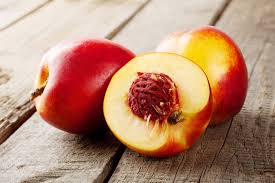Nectarines scientifically known as Prunus persica var. nucipersica are delicious fruits that are a close relative to peaches. They have a smooth skin and a juicy, sweet taste that makes them a favorite among many people. The vibrant orange color of the nectarine’s flesh is not only visually appealing but also an indicator of its ripeness.
These fruits belong to the Rosaceae family and are scientifically known as Prunus persica var. nucipersica. Nectarines share similarities with peaches, but they differ in one significant aspect—the absence of peach fuzz on their skin. This lack of fuzz gives nectarines a smooth texture, making them a preferred choice for those who may find the fuzziness of peaches less appealing.
Nectarines thrive in warm climates, and they are often associated with the summertime due to their peak season, which typically spans from late spring to early fall. This period allows for optimal growth and the development of their natural sweetness. The fruit’s flavor is a delightful combination of tanginess and sweetness, creating a refreshing taste that captivates the palate.
One of the delightful aspects of nectarines is their versatility in culinary applications. They can be enjoyed in various ways, whether eaten fresh, sliced into salads, blended into smoothies, or incorporated into desserts. Their juicy nature makes them a perfect addition to fruit salads, providing a burst of flavor and natural sweetness.
Nutritionally, nectarines offer a range of health benefits. They are a good source of vitamins and minerals, including vitamin C, potassium, and dietary fiber. Vitamin C is known for its antioxidant properties, which help protect the body’s cells from damage caused by free radicals. Potassium plays a crucial role in maintaining proper heart and muscle function, while dietary fiber supports digestive health.
Choosing ripe nectarines is essential for the best taste experience. A ripe nectarine should yield slightly to gentle pressure when touched and emit a fragrant aroma. It’s advisable to store nectarines at room temperature until they reach the desired ripeness, after which they can be refrigerated to prolong their freshness.
In addition, nectarines are a delightful fruit with a smooth texture, sweet taste, and a wealth of nutritional benefits. Whether enjoyed fresh, added to various dishes, or incorporated into healthy snacks, nectarines stand out as a versatile and delicious addition to a balanced diet.
Read Also: Egg Formation and Production Process (From Day-Old to First Lay)
The History of Nectarines (Prunus persica var. nucipersica)

Nectarines have a fascinating history that traces back to ancient times. Originating in China over 2,000 years ago, these fruits were highly valued for their delicious flavor and nutritional benefits. From China, nectarines made their way along the Silk Road, spreading to other parts of Asia and eventually reaching the Middle East.
The cultivation of nectarines began to thrive in ancient Persia (modern-day Iran), where they gained popularity among royalty and the elite. The Persian empire played a pivotal role in spreading the cultivation of nectarines to other regions, contributing to their global dissemination.
During the 16th century, Spanish explorers and traders introduced nectarines to Europe, where they found fertile soil and suitable climates for cultivation. The fruits quickly became a sought-after delicacy among European aristocrats. The word “nectarine” itself is believed to have originated from the Greek word “nekta,” meaning “intoxicating,” underscoring the irresistible allure of these fruits.
As European settlers colonized the Americas, they brought nectarine seeds with them, introducing the fruit to the New World. However, nectarines faced some challenges in North America due to the cold climate, limiting their cultivation to specific regions.
Over the centuries, horticulturists and botanists played a crucial role in refining nectarine varieties through selective breeding, enhancing their taste and appearance. Today, nectarines are grown in various parts of the world, with California, in the United States, being a major hub for commercial production.
The cultivation and popularity of nectarines continue to evolve, influenced by advancements in agriculture, transportation, and global trade. These delectable fruits have not only stood the test of time but have also become a staple in many households worldwide, loved for their sweet flavor and versatility in culinary applications.
The Nutritional Values of Nectarines (Prunus persica var. nucipersica)

Nectarines boast a rich nutritional profile, making them a healthy and flavorful addition to a balanced diet. Here’s a glimpse into the key components of their nutritional value:
1. Vitamins:
Vitamin C: Nectarines are a good source of vitamin C, an essential antioxidant that helps protect cells from damage, supports the immune system, and promotes skin health.
Minerals:
Potassium: These fruits contain potassium, a mineral crucial for maintaining proper heart function, regulating blood pressure, and supporting overall cardiovascular health.
2. Dietary Fiber:
Fiber: Nectarines contribute dietary fiber, which aids in digestion, helps regulate blood sugar levels, and supports a healthy gastrointestinal system.
3. Calories and Macronutrients:
Calories: Nectarines are relatively low in calories, making them a guilt-free snack or addition to meals.
Carbohydrates: They provide a natural source of carbohydrates, primarily in the form of sugars, contributing to their sweet taste.
Protein and Fat: Nectarines are not significant sources of protein or fat.
4. Hydration:
Water Content: With a high water content, nectarines contribute to hydration, making them a refreshing choice, especially during hot weather.
It’s important to note that the specific nutritional content may vary slightly depending on factors such as the size and ripeness of the nectarine. Including nectarines in a diverse and well-balanced diet can contribute to meeting daily nutritional needs and promoting overall health. Whether enjoyed fresh, sliced into salads, or blended into smoothies, nectarines offer a tasty way to incorporate essential vitamins and minerals into your diet.
Read Also: Egg Processing and Storage Methods
The Health Benefits of Nectarines (Prunus persica var. nucipersica)

Nectarines offer a range of health benefits, thanks to their nutrient-rich composition. Here are some key advantages associated with incorporating nectarines into your diet:
1. Antioxidant Protection:
Vitamin C: Nectarines are a good source of vitamin C, an antioxidant that helps protect cells from oxidative stress and supports the immune system.
2. Heart Health:
Potassium: The potassium content in nectarines plays a role in regulating blood pressure, supporting heart health, and reducing the risk of cardiovascular diseases.
3. Digestive Health:
Dietary Fiber: Nectarines contribute dietary fiber, which aids digestion, helps prevent constipation, and supports a healthy digestive system.
4. Hydration:
Water Content: With a high water content, nectarines contribute to overall hydration, supporting various bodily functions and promoting skin health.
5. Weight Management:
Low Calorie Content: Nectarines are relatively low in calories, making them a satisfying and nutritious snack option for those looking to manage their weight.
6. Skin Health:
Vitamin C: The antioxidant properties of vitamin C in nectarines contribute to skin health by supporting collagen production, which is essential for maintaining skin elasticity.
7. Immune System Support:
Vitamin C: Nectarines play a role in supporting the immune system, helping the body defend against infections and illnesses.
8. Nutrient Variety:
Multiple Nutrients: Nectarines provide a combination of vitamins and minerals, contributing to overall nutritional diversity and helping meet daily nutrient requirements.
It’s important to include a variety of fruits and vegetables in your diet to ensure a broad range of nutrients. While nectarines offer these health benefits, they are most effective when part of a well-rounded and balanced eating plan. Always consult with a healthcare professional or nutritionist for personalized advice on your dietary needs and health goals.
How to Grow Nectarines (Prunus persica var. nucipersica)
Growing nectarines can be a rewarding experience, and with proper care, you can enjoy fresh, homegrown fruit. Here are the basic steps on how to grow nectarines:
1. Selecting a Suitable Location: Choose a location with full sunlight exposure, as nectarines thrive in sunny conditions. Ensure good air circulation to prevent diseases.
2. Soil Preparation: Nectarines prefer well-draining soil with a slightly acidic to neutral pH. Incorporate organic matter like compost into the soil to enhance fertility.
3. Choosing Nectarine Varieties: Select a nectarine variety suited to your climate zone. Consider factors such as chill hours (the number of hours below a certain temperature during winter), as this affects fruit production.
4. Planting Nectarine Trees: Plant nectarine trees in late winter or early spring when the soil is workable. Dig a hole wide enough to accommodate the root system and plant the tree at the same depth it was in the nursery container.
5. Spacing: Provide adequate space between nectarine trees to allow for proper air circulation and future growth. Follow the recommended spacing guidelines for the specific variety you are planting.
6. Watering: Nectarines require regular watering, especially during dry periods. Ensure the soil is consistently moist but not waterlogged. Deep, infrequent watering is preferable to shallow, frequent watering.
7. Fertilizing: Apply a balanced fertilizer in spring before new growth starts. Follow the recommended dosage based on the age and size of the tree. Avoid excessive nitrogen, as it can lead to excessive foliage growth at the expense of fruit production.
8. Pruning: Prune nectarine trees during the dormant season to remove dead or diseased branches and shape the tree for optimal sunlight penetration. Thinning the canopy helps improve air circulation.
9. Thinning Fruit: When the fruit begins to develop, thin it to allow for proper spacing and larger, healthier nectarines. This helps prevent overcrowding and improves fruit quality.
10. Pest and Disease Management: Keep an eye out for common pests like aphids and diseases such as brown rot. Use organic or chemical controls as needed, and address issues promptly to protect the health of the tree.
11. Harvesting: Harvest nectarines when they are fully ripe. The fruit should yield slightly to gentle pressure and have a fragrant aroma. Be careful not to bruise the fruit during harvesting.
Read Also: Best Organic Fertilizer for Vegetables
